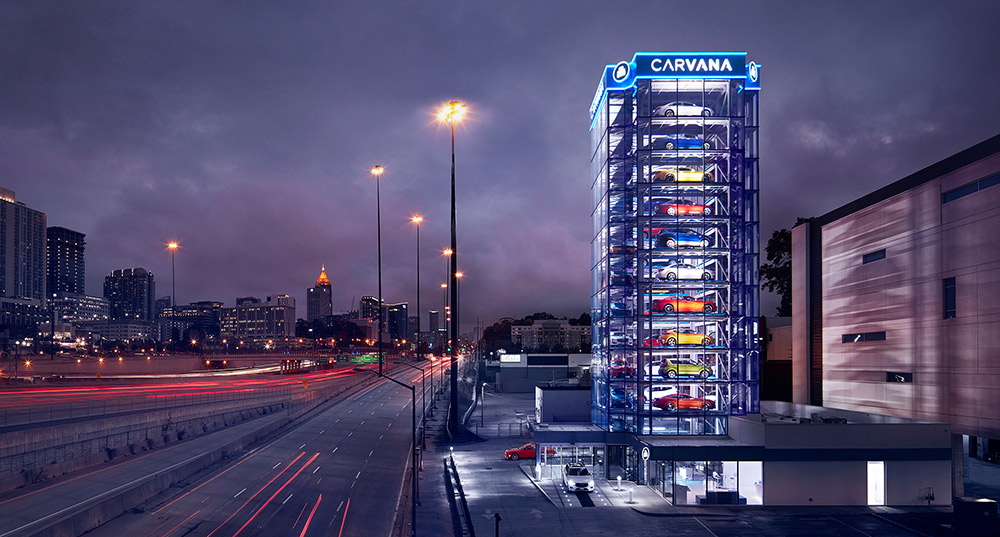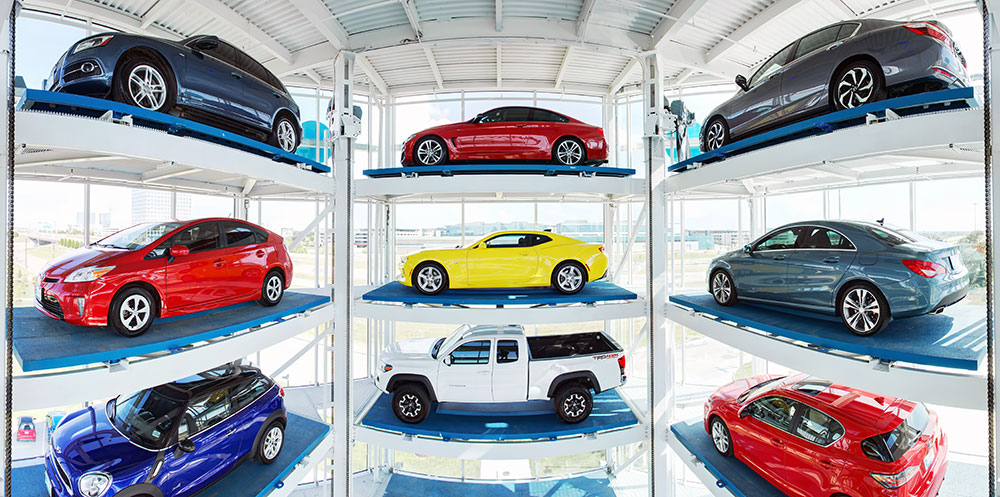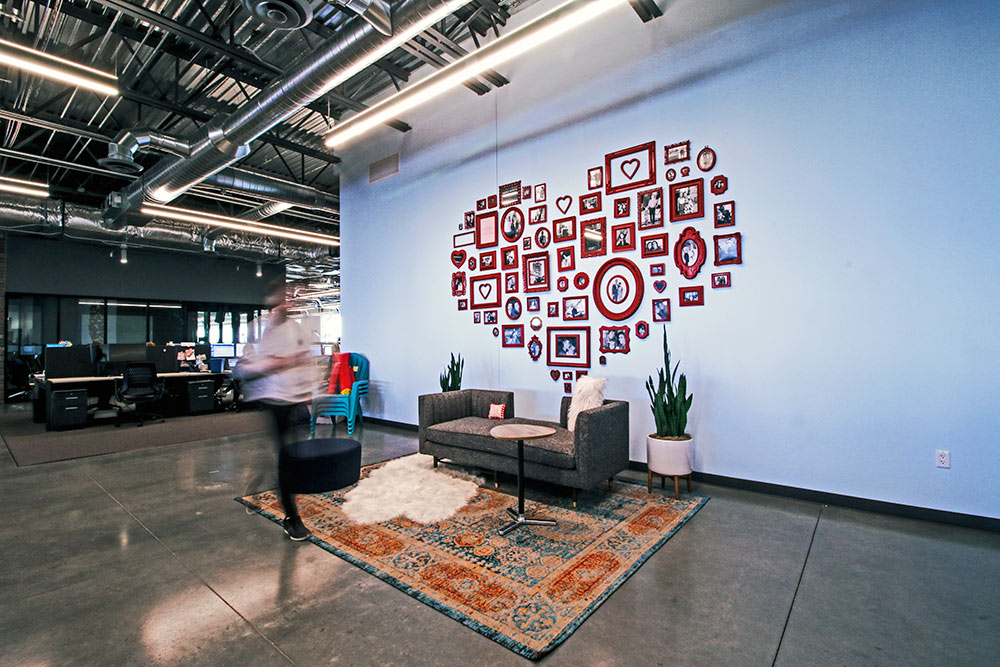
在每个成功的初创公司的故事背后,都存在一个转折点事件。那么都是哪些差异化因素让这些企业能够从最初的弱不禁风,发展到根深叶茂呢?
对Carvana来说,答案很简单:一篇Word文档。
Carvana的三名创始人,厄尼•加西亚、本•休斯顿和莱恩•基顿始终在其他们的友谊关系中保持着一种节奏,这种方式似乎对其雄心勃勃的初创项目大有裨益。
这三位来自常春藤联盟的毕业生都有着相同的幽默感,而且从一开始就约定,既要拼命地工作,又要保持开心的状态。很明显,这一理念对他们在公司创建之初招聘的少数雇员有着莫大的吸引力,他们纷纷希望加入公司,并为之努力工作。
然而,随着这家总部位于菲尼克斯的公司发展壮大,鉴于在每天的工作时间里,不再是全体员工围坐在同一张桌子旁,“我们必须将这种文化正式化,才可以继续引起人们的共鸣。”首席执行官加西亚说道。
加西亚还记得自己曾经与首席品牌官基顿,和首席运营官休斯顿一道草拟了企业价值主张,当时他们一左一右地坐在加西亚身旁。
加西亚说:“这个版本书呆子气十足,全是高大上的理念。”这个清单随后得到了不断改进,最终演变成了公司在所有招聘、解雇、汽车销售、团队会议、战略举措,以及这期间公司从事任何工作时所遵循的文件。
实事求是地讲,正是这份Word文档让Carvana发展成了一家营业收入达56亿美元的公司,并颠覆了客户的汽车购买体验。
亚马逊最初于2002年入选《财富》美国500强,当时公司刚刚才创建8年的时间。谷歌也是在成立8年后才进入该榜单。
那么进榜速度第三快的公司是哪家?答案是Carvana。
该公司拥有1万多名雇员,遍布美国298个城市,是入选该榜单最年轻的公司(与Facebook打平),而且其年增速达到了42%。公司在新冠疫情期间也没有裁员或强制员工休假。
Carvana模式背后的技术非常了不起,它的本质就是二手车贩卖机。顾客能够在公司网站搜索和查验二手车,然后可以选择送货上门(仅需24小时),或者前往贩卖机处领取自己的新车,这是一个完全自动化的投币式神奇装置(共有28个),能够按需配送已购买车辆。在那里,车辆已经完全准备就绪,等待车主将其开回家。
这项业务采用了轴辐式的模式,没有经销商和收取佣金的销售代表,而是依赖于客户需求向导团队,以虚拟的形式帮助客户完成交易。确实,这个理念十分吸引眼球,而且深受人们欢迎。
事实证明,这项业务的根基在于其合理的可扩张性,以及坚如磐石的文化,这些一直以来都得益这个团队乐天派的远大志向。
第二次说不定就会成功
在Carvana这个点子诞生之前,Carvana其中的两名创始人曾经在2010年第一次创业,成立了一家名为Looterang的公司,但以失败告终。
在就读斯坦福大学时,加西亚和休斯顿于大二时相识。毕业后,加西亚就读了财务专业,而休斯顿去了哈佛法学院,但这两位会经常讨论创业点子。
Looterang是一个移动应用程序,根据一个专属的预测算法,为消费者提供个性化的本土交易。加西亚说,这个应用程序之所以会失败,是因为他们二人对于其适用的行业还不够了解。
因此,第二次尝试必须是他与休斯顿完全熟知的行业。加西亚从小就十分熟悉汽车业务,从15岁开始,他一到夏天就会在他父亲开的二手汽车店给父亲打下手,这家店名为DriveTime,是一家传统的二手汽车店,但却异常成功。
加西亚和休斯顿认为自己还有机会。加西亚说:“我们一直努力寻找人们在离开汽车经销店时会如此不悦的原因。这个问题可以解决吗?我们最终决定尝试的这个点子,酷似电商,但又有所不同。”
2012年,这两位与基顿合作,成立了Carvana,一开始作为DriveTime的子公司。他们与基顿是在组建Looterang时认识的。
加西亚说:“汽车行业是美国最大的垂直零售行业,而且人们普遍认为其客户体验会令人感到不悦。”
加西亚说,很明显,试驾并非Carvana的关注点,而且公司也不打算将钱用于传统经销商模式的经营支出。联合创始人希望为客户打造一种亲自提车的体验。
最初的想法是建造一种车库,它配备了玻璃门和键盘按键。对比运送交车,这种方式能够让客户的提车时间缩短一天,并为其提供有趣的体验。车库的建造成本约为15万美元,被笑称为汽车贩卖机。
当然,这种机器也得到了一些媒体的报道,这种模式得以迅速升温,推动其生产真正的汽车贩卖机。在进行了一番调查之后,这几位创始人在德国发现了一家可以提供帮助的工程公司。

2015年11月,加西亚、休斯顿和基顿在纳什维尔发布了其首款贩卖机。这个专利项目的成本达到了数百万美元,并让公司踏上了前所未有的增长之旅。
加西亚说,大多数传统经销模式的沉没成本为1000万美元至2000万美元,每月销售约100辆至200辆车。Carvana每月的销量超过了1000辆,但成本只占其投资的一小部分,也就是每辆车大概能够给客户省1400美元。
公司的股票自2017年首次公开募股之后出现暴跌,但自此之后又大幅回升。IBISWorld的分析师在报告中称,Carvana在线上二手汽车市场的份额达到了24%。该报告还预测其营收将在2022年超过80亿美元。
Carvana文化
Carvana的创始人称,这个成长故事的源于一个每人都能感同身受的理念:你的下一位客户可能是你的母亲。
这也是客户需求向导瑞切尔•海恩斯所宣传的理念,她在2020年5月说服了一位得克萨斯州丈夫购买了一辆宝马汽车,并将其作为其妻子的母亲节礼物,而这位妻子当时刚刚战胜了癌症。海恩斯在交付日给这对夫妻送上了一份惊喜,她在车的后排塞满了气球和贺卡,并赠送了一个礼物篮,里面装着她亲自编织的毯子,一瓶香槟以及一张星巴克礼物卡。
没有人要求她这样做,而且也并非是其职责要求,也与佣金无关。(Carvana从未提供过佣金。)
基顿说:“我们从一开始就会强调这件事情:我们每次都会选择那些拥有最佳技能的人选。专家也无法左右我们的文化。”
他说,说到为什么这类事件会经常在Carvana发生,原因就在于公司对文化的持续关注。“将你的母亲想象为销售终端接收用户”便是公司的七大指导原则之一。
其余原则包括:我们是一条船上的人;没有局外人一说;要勇敢;急转前行;保持昂扬斗志;而且不要成为混球。
休斯顿称,在经历了一段时间之后,内部品牌团队最终拿出了完整的文件版本。
他说:“我们将其看作一场宣传活动,并耗费了数个月的时间。大多数雇员都开始注意公司的价值。我们不得不考虑我们招聘的方式、对待他人的方式,以及如何克服困难时期。内容必须做到通俗易懂。只有这样才能够确立一种让人感到真实可信的文化。”
商业地产中介公司Keyser的首席执行官、《成功无需冷血:混蛋无私奉献的艺术》(You Don’t Have to Be Ruthless to Win: The Art of Badass Selfless Service.)一书的作者乔纳森•凯泽称,将这个Word文档转化为一种可以引发共鸣的活动,然后形成一种真实的运营节奏,是Carvana实现自身差异化的真正原因。
“经过精心设定的文化对长期成功来说异常重要。我一直都在说:‘鱼总是从头开始腐烂。’”
他说,要说如何在招聘和挽留问题出现之前就解决这些问题,Carvana是一个绝佳案例:“如果‘向前走’是一种重要的行事方式,那么人们就有必要去审视自己以何为目标。如果有人犯了错误,你是否会及时发出警告?此举会发出的信息是:请稳扎稳打。人们都会寻找真实可靠的组织。“如果公司弄清楚自己的长处和短处,那么强大的企业文化会为之带来良好的口碑。”
特蕾莎•阿拉贡称自己是Carvana的官方指南,她是公司自2013年成立之后招聘的第一名员工。作为客户体验副总裁,阿拉贡支持并管理着一支面向客户的需求向导团队。她会处理各类问题,而且会耗费很多时间来解决问题。
她在谈论其团队的零佣金支付构架时说:“我在这里的作用不是凑数,也不是维持现状。我们的一个价值观就是‘不要做混球’。我们并不在乎你有多精明。如果你是混球,那么你并不适合在这里工作。”
与阿拉贡谈论工作的过程中,收获了很多与客户需求向导有关的故事。其中包括在交付日以一种特别的方式露面,或收到客户为感谢他们提供的个人服务而赠送了几袋开心果,亦或是在疫情培训期间进行Zoom会议时的欢聚时刻。

要说Carvana的文化是否经得起时间的考验,那么去年波及甚广的新冠疫情便说明了一切。
随着各大企业纷纷推出裁员计划,全球因为恐慌而陷入停滞,Carvana的各位联合创始人以公司价值为准绳,做出了有利于公司发展的下一步决定。
加西亚说:“我们的业务正在以三位数的速度增长。我们就没有想过拒绝客户的需求。当没有交易可做时,企业难以承担的那些费用,恰好是我们可以给客户带来的交易福利。”
Carvana完全避免了裁员,但这几位创始人很快削减了所有业务80%的工作时长,并捐赠了自己的所有薪资来弥补空缺。他们还创建了一只基金来造福这些雇员,同时还降低了其工作时长。
超过500名雇员都捐赠了一部分薪水,最后筹集了数百万美元,在疫情期间帮助所有员工维持了80%的最低薪资。
加西亚说:“就内心和人性而言,这是我们所干过的最酷的事情。在这一期间,我们通过直面恐惧和不确定性,来检验公司的价值是否是真实的。事实证明,答案是肯定的。”
疫情也考验了客户体验。由于离开其家庭或与他人互动的民众越来越少,Carvana团队予以积极应对,并实施了一个无接触交付项目,它通过在一天之内于24个州开设100个新的市场,来应对线上汽车销售的小幅上涨。
基顿说:“在一周半之内,我们所做的工作比以前几个月都还多。”
当被问及疫情期间在Carvana的工作状况时,阿拉贡毫不犹豫地说:“2020年成为了我们的助力。对于不幸的经历,向他人展现自己的热情和同情是十分正常的事情。我们并非以卖车为目的,而是在为客户打造一种体验。这里的人和文化让我们能够继续经营,而且我们也在尽心尽力地保护这一切。”
休斯顿对此表示同意,并肯定了公司集体的乐观态度,即便面临繁重的工作和困境时亦是如此:“我们从疫情中学到的是:所有的事情都变得更困难了,而且问题需要更长的时间来解决。地道尽头是没有灯的,因此我们不得不去适应在地道中的生活,并在黑暗中摸索,苦中作乐。”
所以,请千万不要当混球。(财富中文网)
译者:冯丰
审校:夏林
在每个成功的初创公司的故事背后,都存在一个转折点事件。那么都是哪些差异化因素让这些企业能够从最初的弱不禁风,发展到根深叶茂呢?
对Carvana来说,答案很简单:一篇Word文档。
Carvana的三名创始人,厄尼•加西亚、本•休斯顿和莱恩•基顿始终在其他们的友谊关系中保持着一种节奏,这种方式似乎对其雄心勃勃的初创项目大有裨益。
这三位来自常春藤联盟的毕业生都有着相同的幽默感,而且从一开始就约定,既要拼命地工作,又要保持开心的状态。很明显,这一理念对他们在公司创建之初招聘的少数雇员有着莫大的吸引力,他们纷纷希望加入公司,并为之努力工作。
然而,随着这家总部位于菲尼克斯的公司发展壮大,鉴于在每天的工作时间里,不再是全体员工围坐在同一张桌子旁,“我们必须将这种文化正式化,才可以继续引起人们的共鸣。”首席执行官加西亚说道。
加西亚还记得自己曾经与首席品牌官基顿,和首席运营官休斯顿一道草拟了企业价值主张,当时他们一左一右地坐在加西亚身旁。
加西亚说:“这个版本书呆子气十足,全是高大上的理念。”这个清单随后得到了不断改进,最终演变成了公司在所有招聘、解雇、汽车销售、团队会议、战略举措,以及这期间公司从事任何工作时所遵循的文件。
实事求是地讲,正是这份Word文档让Carvana发展成了一家营业收入达56亿美元的公司,并颠覆了客户的汽车购买体验。
亚马逊最初于2002年入选《财富》美国500强,当时公司刚刚才创建8年的时间。谷歌也是在成立8年后才进入该榜单。
那么进榜速度第三快的公司是哪家?答案是Carvana。
该公司拥有1万多名雇员,遍布美国298个城市,是入选该榜单最年轻的公司(与Facebook打平),而且其年增速达到了42%。公司在新冠疫情期间也没有裁员或强制员工休假。
Carvana模式背后的技术非常了不起,它的本质就是二手车贩卖机。顾客能够在公司网站搜索和查验二手车,然后可以选择送货上门(仅需24小时),或者前往贩卖机处领取自己的新车,这是一个完全自动化的投币式神奇装置(共有28个),能够按需配送已购买车辆。在那里,车辆已经完全准备就绪,等待车主将其开回家。
这项业务采用了轴辐式的模式,没有经销商和收取佣金的销售代表,而是依赖于客户需求向导团队,以虚拟的形式帮助客户完成交易。确实,这个理念十分吸引眼球,而且深受人们欢迎。
事实证明,这项业务的根基在于其合理的可扩张性,以及坚如磐石的文化,这些一直以来都得益这个团队乐天派的远大志向。
第二次说不定就会成功
在Carvana这个点子诞生之前,Carvana其中的两名创始人曾经在2010年第一次创业,成立了一家名为Looterang的公司,但以失败告终。
在就读斯坦福大学时,加西亚和休斯顿于大二时相识。毕业后,加西亚就读了财务专业,而休斯顿去了哈佛法学院,但这两位会经常讨论创业点子。
Looterang是一个移动应用程序,根据一个专属的预测算法,为消费者提供个性化的本土交易。加西亚说,这个应用程序之所以会失败,是因为他们二人对于其适用的行业还不够了解。
因此,第二次尝试必须是他与休斯顿完全熟知的行业。加西亚从小就十分熟悉汽车业务,从15岁开始,他一到夏天就会在他父亲开的二手汽车店给父亲打下手,这家店名为DriveTime,是一家传统的二手汽车店,但却异常成功。
加西亚和休斯顿认为自己还有机会。加西亚说:“我们一直努力寻找人们在离开汽车经销店时会如此不悦的原因。这个问题可以解决吗?我们最终决定尝试的这个点子,酷似电商,但又有所不同。”
2012年,这两位与基顿合作,成立了Carvana,一开始作为DriveTime的子公司。他们与基顿是在组建Looterang时认识的。
加西亚说:“汽车行业是美国最大的垂直零售行业,而且人们普遍认为其客户体验会令人感到不悦。”
加西亚说,很明显,试驾并非Carvana的关注点,而且公司也不打算将钱用于传统经销商模式的经营支出。联合创始人希望为客户打造一种亲自提车的体验。
最初的想法是建造一种车库,它配备了玻璃门和键盘按键。对比运送交车,这种方式能够让客户的提车时间缩短一天,并为其提供有趣的体验。车库的建造成本约为15万美元,被笑称为汽车贩卖机。
当然,这种机器也得到了一些媒体的报道,这种模式得以迅速升温,推动其生产真正的汽车贩卖机。在进行了一番调查之后,这几位创始人在德国发现了一家可以提供帮助的工程公司。
2015年11月,加西亚、休斯顿和基顿在纳什维尔发布了其首款贩卖机。这个专利项目的成本达到了数百万美元,并让公司踏上了前所未有的增长之旅。
加西亚说,大多数传统经销模式的沉没成本为1000万美元至2000万美元,每月销售约100辆至200辆车。Carvana每月的销量超过了1000辆,但成本只占其投资的一小部分,也就是每辆车大概能够给客户省1400美元。
公司的股票自2017年首次公开募股之后出现暴跌,但自此之后又大幅回升。IBISWorld的分析师在报告中称,Carvana在线上二手汽车市场的份额达到了24%。该报告还预测其营收将在2022年超过80亿美元。
Carvana文化
Carvana的创始人称,这个成长故事的源于一个每人都能感同身受的理念:你的下一位客户可能是你的母亲。
这也是客户需求向导瑞切尔•海恩斯所宣传的理念,她在2020年5月说服了一位得克萨斯州丈夫购买了一辆宝马汽车,并将其作为其妻子的母亲节礼物,而这位妻子当时刚刚战胜了癌症。海恩斯在交付日给这对夫妻送上了一份惊喜,她在车的后排塞满了气球和贺卡,并赠送了一个礼物篮,里面装着她亲自编织的毯子,一瓶香槟以及一张星巴克礼物卡。
没有人要求她这样做,而且也并非是其职责要求,也与佣金无关。(Carvana从未提供过佣金。)
基顿说:“我们从一开始就会强调这件事情:我们每次都会选择那些拥有最佳技能的人选。专家也无法左右我们的文化。”
他说,说到为什么这类事件会经常在Carvana发生,原因就在于公司对文化的持续关注。“将你的母亲想象为销售终端接收用户”便是公司的七大指导原则之一。
其余原则包括:我们是一条船上的人;没有局外人一说;要勇敢;急转前行;保持昂扬斗志;而且不要成为混球。
休斯顿称,在经历了一段时间之后,内部品牌团队最终拿出了完整的文件版本。
他说:“我们将其看作一场宣传活动,并耗费了数个月的时间。大多数雇员都开始注意公司的价值。我们不得不考虑我们招聘的方式、对待他人的方式,以及如何克服困难时期。内容必须做到通俗易懂。只有这样才能够确立一种让人感到真实可信的文化。”
商业地产中介公司Keyser的首席执行官、《成功无需冷血:混蛋无私奉献的艺术》(You Don’t Have to Be Ruthless to Win: The Art of Badass Selfless Service.)一书的作者乔纳森•凯泽称,将这个Word文档转化为一种可以引发共鸣的活动,然后形成一种真实的运营节奏,是Carvana实现自身差异化的真正原因。
“经过精心设定的文化对长期成功来说异常重要。我一直都在说:‘鱼总是从头开始腐烂。’”
他说,要说如何在招聘和挽留问题出现之前就解决这些问题,Carvana是一个绝佳案例:“如果‘向前走’是一种重要的行事方式,那么人们就有必要去审视自己以何为目标。如果有人犯了错误,你是否会及时发出警告?此举会发出的信息是:请稳扎稳打。人们都会寻找真实可靠的组织。“如果公司弄清楚自己的长处和短处,那么强大的企业文化会为之带来良好的口碑。”
特蕾莎•阿拉贡称自己是Carvana的官方指南,她是公司自2013年成立之后招聘的第一名员工。作为客户体验副总裁,阿拉贡支持并管理着一支面向客户的需求向导团队。她会处理各类问题,而且会耗费很多时间来解决问题。
她在谈论其团队的零佣金支付构架时说:“我在这里的作用不是凑数,也不是维持现状。我们的一个价值观就是‘不要做混球’。我们并不在乎你有多精明。如果你是混球,那么你并不适合在这里工作。”
与阿拉贡谈论工作的过程中,收获了很多与客户需求向导有关的故事。其中包括在交付日以一种特别的方式露面,或收到客户为感谢他们提供的个人服务而赠送了几袋开心果,亦或是在疫情培训期间进行Zoom会议时的欢聚时刻。
要说Carvana的文化是否经得起时间的考验,那么去年波及甚广的新冠疫情便说明了一切。
随着各大企业纷纷推出裁员计划,全球因为恐慌而陷入停滞,Carvana的各位联合创始人以公司价值为准绳,做出了有利于公司发展的下一步决定。
加西亚说:“我们的业务正在以三位数的速度增长。我们就没有想过拒绝客户的需求。当没有交易可做时,企业难以承担的那些费用,恰好是我们可以给客户带来的交易福利。”
Carvana完全避免了裁员,但这几位创始人很快削减了所有业务80%的工作时长,并捐赠了自己的所有薪资来弥补空缺。他们还创建了一只基金来造福这些雇员,同时还降低了其工作时长。
超过500名雇员都捐赠了一部分薪水,最后筹集了数百万美元,在疫情期间帮助所有员工维持了80%的最低薪资。
加西亚说:“就内心和人性而言,这是我们所干过的最酷的事情。在这一期间,我们通过直面恐惧和不确定性,来检验公司的价值是否是真实的。事实证明,答案是肯定的。”
疫情也考验了客户体验。由于离开其家庭或与他人互动的民众越来越少,Carvana团队予以积极应对,并实施了一个无接触交付项目,它通过在一天之内于24个州开设100个新的市场,来应对线上汽车销售的小幅上涨。
基顿说:“在一周半之内,我们所做的工作比以前几个月都还多。”
当被问及疫情期间在Carvana的工作状况时,阿拉贡毫不犹豫地说:“2020年成为了我们的助力。对于不幸的经历,向他人展现自己的热情和同情是十分正常的事情。我们并非以卖车为目的,而是在为客户打造一种体验。这里的人和文化让我们能够继续经营,而且我们也在尽心尽力地保护这一切。”
休斯顿对此表示同意,并肯定了公司集体的乐观态度,即便面临繁重的工作和困境时亦是如此:“我们从疫情中学到的是:所有的事情都变得更困难了,而且问题需要更长的时间来解决。地道尽头是没有灯的,因此我们不得不去适应在地道中的生活,并在黑暗中摸索,苦中作乐。”
所以,请千万不要当混球。(财富中文网)
译者:冯丰
审校:夏林
Behind every successful startup story is a tipping point anecdote. What’s the differentiator that helped you get from A to B to Z?
For Carvana, the answer is simply: a Word document.
Carvana’s three founders—Ernie Garcia, Ben Huston, and Ryan Keeton—always had an operating rhythm in their friendship that seemed to serve their ambitious startup well. The trio of Ivy League grads also shared the same sense of humor and agreed from the start to work hard and have fun at the same breakneck pace. It’s clear how the few employees they had gathered early on fed off that energy, wanting to play along and work hard too.
But as the Phoenix-based company grew, and workdays no longer took place with the whole Carvana staff sitting around the same table, “that culture needed to be formalized to continue to resonate,” says CEO Garcia, who recalls typing the first loose draft of the business’s value statement, with Keeton, chief brand officer, looking over his right shoulder, and Huston, chief operating officer, over his left. “That version was a bunch of nerdy, high-minded concepts,” Garcia says. The list evolved and evolved and evolved into the document the company relies on in every hiring, firing, car sale, team meeting, strategic move, and everything in between. It’s not an overstatement to say that the Word doc turned Carvana into a $5.6 billion business that has transformed the customer car-buying experience.
Amazon first made the Fortune 500 in 2002, after just eight years in business. Google also landed on the list eight years from launch, in 2006. The third fastest company to make the list? Carvana. With more than 10,000 employees and spanning 298 U.S. markets, it’s one of the youngest companies to be listed on the Fortune 500 (tied with Facebook), and has managed an annual growth rate of 42% without a single layoff or furlough throughout the pandemic.
The technology behind the Carvana model—a used car vending machine—is pretty remarkable. Search for and vet used cars on the company site, then either have it delivered to your door or, in as little as 24 hours, collect the new-to-you car at one of 28 fully automated, coin-operated contraptions that dispense purchased vehicles on demand, completely prepped and ready for your ride home. The business is a hub-and-spoke setup with no dealerships and instead of commissioned sales reps relies on a team of customer advocates to virtually walk the customer through the deal. The concept is catchy and mediagenic, for sure. And, it turns out, the business is built on a foundation of legitimate scalability and rock-solid culture, all through the lens of glass-half-full ambition.
Second time’s the charm
The idea came after two of the three Carvana founders tried their hand at a failed first startup called Looterang in 2010. Garcia and Huston met as sophomores at Stanford University. After graduation, Garcia went into finance and Huston to Harvard Law School, but the pair regularly brainstormed startup ideas. Looterang, a mobile app offering consumers personalized, local deals based off a proprietary, predictive algorithm, tanked in part because the two didn’t know enough about the industry to make it work, says Garcia. The second go had to be built in an industry he or Huston knew inside and out. Garcia grew up in and around the car business, working every summer since the age of 15 with his dad, who owned and ran a traditional and incredibly successful used car business called DriveTime. Garcia and Huston felt they had a shot. “We were trying to focus on why people left car dealerships with a stomachache,” says Garcia. “Is that solvable? We settled on something that looks a lot like e-commerce but isn’t entirely that.”
In 2012, the two joined forces with Keeton, whom they had met while building Looterang, to launch Carvana, at first as a subsidiary of DriveTime. “The automotive industry is the largest retail vertical in the country,” says Garcia. “It’s also the most recognized as an uncomfortable customer experience.”
It was clear from the outset, says Garcia, that Carvana had zero interest in test-drives and didn’t want the overhead of a traditional dealership. Still, the cofounders wanted to create an experience for the customer to pick the car up in person. The initial effort came in the form of a garage with glass doors and a keypad. It enabled the customer to get the car a day faster than by delivery and provided a fun reveal. The garage cost about $150,000 to produce and was jokingly called the car vending machine. That, of course, got some media coverage, which in turn escalated quickly to producing an actual car vending machine. After some due diligence, the founders identified an engineering firm in Germany to help them.
In November 2015, Garcia, Huston, and Keeton debuted their vending machine in Nashville. The patented project cost several million dollars and set the company up for unprecedented growth. Most traditional dealerships, says Garcia, have a sunk cost of $10 million to $20 million and sell roughly 100 to 200 cars per month. At Carvana, they sell well over 1,000 cars per month at a fraction of the investment, passing on roughly $1,400 in savings per car sale to the customer. While the company’s stock plummeted after its IPO in 2017, since then they have seen impressive growth. Analysts at IBISWorld report that Carvana holds 24% of the online used car market and project its revenue will reach over $8 million by the start of 2022.
Carvana culture
This growth story, say the Carvana founders, is rooted in a single concept to which nearly every human can relate: Your next customer could be your mom. And that’s what Rachel Haynes, a customer advocate, was shooting for when in May 2020 she managed the sale of a BMW to one Texas husband as a Mother’s Day surprise for his wife, who had recently beat cancer. Haynes surprised the couple on delivery day, filling the back seat of the car with balloons, signs of congratulations, and a gift basket stocked with a blanket she crocheted, a bottle of Champagne, and a Starbucks gift card. No one asked her to do that; it isn’t in her job description and had no bearing on a commission check (Carvana doesn’t offer any to begin with).
“We said it from an early stage: We’ll take the best person with the best skill set every time,” says Keeton. “No expert is worth a ding to our culture.” That constant focus on culture is why, he says, anecdotes like that aren’t outliers at Carvana. Envisioning your mom on the receiving end of a sale is one of the company’s seven guiding principles. The remainder: We’re all in this together; there are no sidelines; be brave; zag forward; stay scrappy; and don’t be a Richard.
Over time, Huston says, the list was ultimately massaged by an internal branding team. “We treated it like a campaign and spent months on it,” he says. “Most employees roll their eyes at company values. We had to consider how we hire, how we treat people, how we navigate difficult times. It has to be palatable and digestible. That’s how you cement culture that feels authentic.” Translating that Word document into a resonant campaign, and then into an authentic operating rhythm, is really where Carvana has differentiated itself, says Jonathan Keyser, CEO at Keyser commercial real estate brokerage and author of You Don’t Have to Be Ruthless to Win: The Art of Badass Selfless Service. “Intentionally designed culture is critical for long-term success,” says Keyser. “And it has to come from the top. I always say, ‘A fish rots from the head.’”
Carvana, he says, is an excellent example of how walking the talk can solve hiring and retention issues before they even arise: “If zagging forward is important, you need to look at what you’re celebrating. If someone makes a mistake and is ‘zagging,’ do you admonish them? That sends the message, ‘Play safe.’ People are looking for an organization that’s authentic. If you are clear about what you are and what you aren’t, then having a strong culture does its own vetting.”
Teresa Aragon describes herself as a Carvana OG, one of the first employees hired after the company’s launch in 2013. In her role as the VP of customer experience, Aragon supports and manages a customer-facing team of advocates. She fields all sorts of questions and spends a lot of her time solving problems. “You’re not here to join the lineup or maintain status quo,” she says, noting the zero commission pay structure on her team. “One of our values is ‘Don’t be a Richard.’ We don’t care how smart you are. If you’re a Richard, you’re not going to be here.” A conversation with Aragon about her job seems to splinter off into side stories about customer advocates making special appearances on delivery day, or receiving bags of pistachios as a thank-you for personal service, or having kumbaya moments over Zoom calls during pandemic training sessions.
If ever there was a time to test Carvana’s culture, it was over the course of the past year’s sweeping pandemic. As businesses planned for layoffs and the world slowed to a panicked halt, the Carvana cofounders turned to its values for the company’s next right step. “We are a business growing at triple-digit rates,” says Garcia. “We weren’t positioned at all to have someone turn off demand. When transactions dry up, the expenses the business can’t afford to take on are exactly the expenses making these transactions positive for our customers.”
Carvana was able to totally sidestep layoffs, but the founders quickly cut 80% of hours across all operations and committed their entire salaries to help cover the difference. They also created a fund to benefit those employees with reduced hours. More than 500 employees contributed from their salaries to raise millions, helping everyone maintain a minimum of 80% of their pay for the duration of the pandemic. “In terms of something deep and human, that’s the coolest thing we’ve ever done,” says Garcia. “That was a moment we faced fear and uncertainty to see if our values were real. Turns out they were.”
The pandemic tested the customer experience, too. With fewer people wanting to leave their homes or interact with anyone at all, the Carvana team was able to pivot and implement a program called Touchless Delivery that addressed the uptick in online car sales by opening 100 additional markets across 24 states in just one day. “In the span of a week and a half we did more work than we had in months,” says Keeton.
When asked about working at Carvana through the pandemic, Aragon doesn’t hesitate: “2020 helped us,” she says. “It is okay to have passion and show empathy for a terrible experience. We are not pushing a sale; we are creating an experience for our customers. The people and the culture here have allowed us to sustain. We protect it dearly.” Huston agrees, affirming the company’s collective optimism, even through hard work and impossible circumstances: “One of the lessons we have taken away is everything is harder and takes longer. There is no light at the end of the tunnel; you just have to get comfortable living in the tunnel and make the tunnel fun.”
And please, don't be a Richard.






